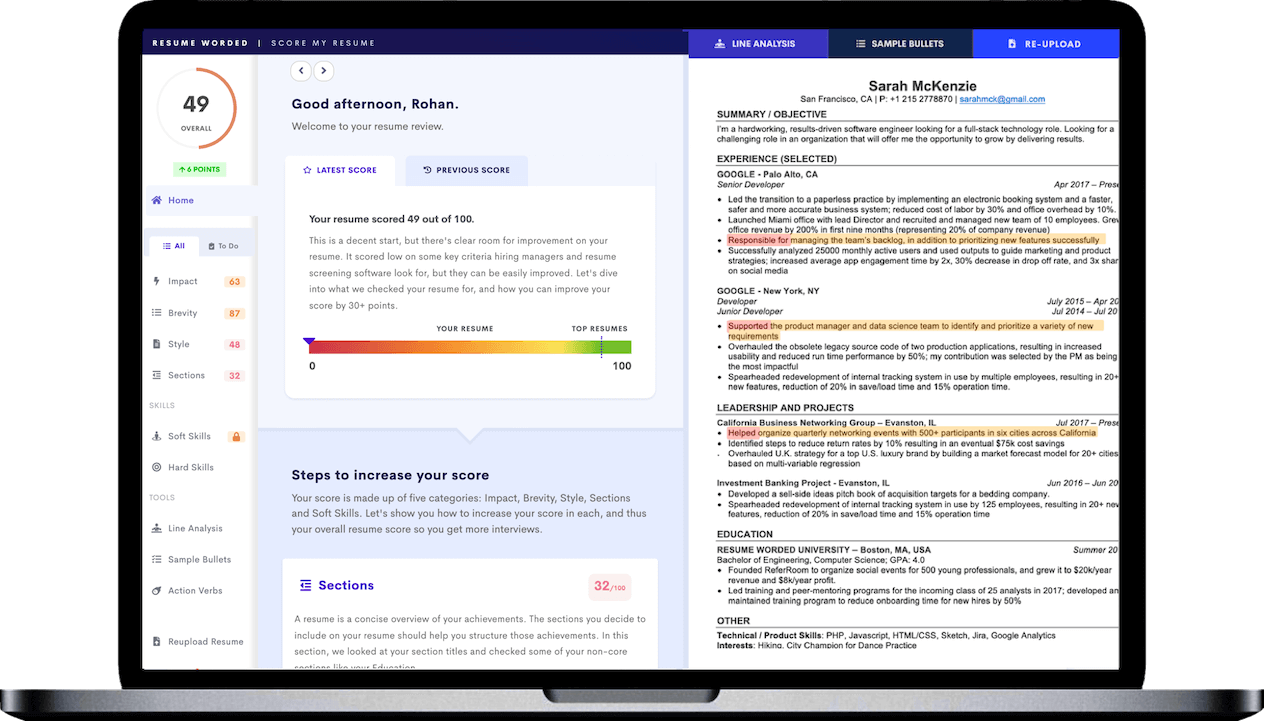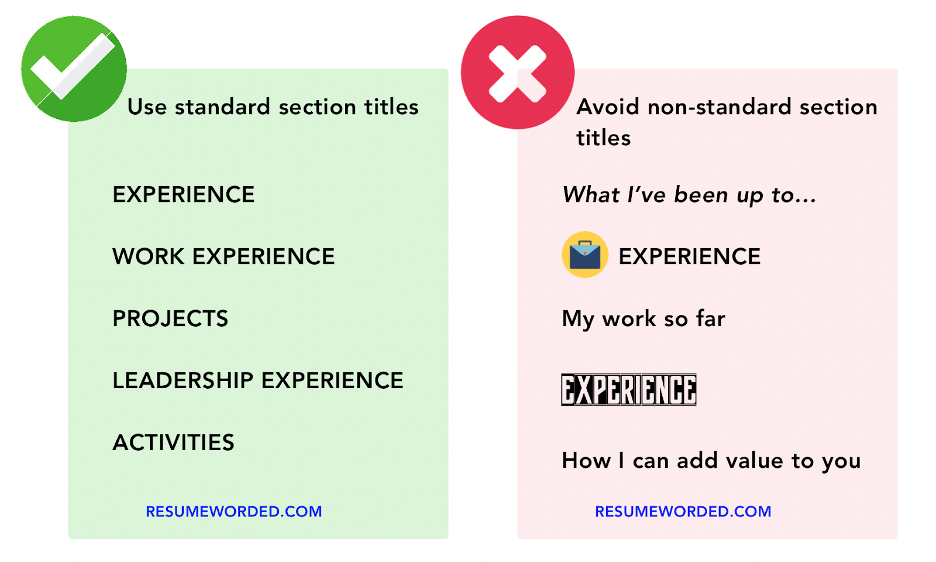One of the unwritten rules of resume writing is this: Not everything that can go on your resume, should go on your resume. Counter-intuitively, there are some things that can actively harm your candidacy — including a too-long work history.
In this guide, we'll cover how many years your resume should go back, what to do if you have more (or less) experience, and when to break those rules.
How many years of work history should you include on a resume?
While there’s no hard and fast rule, the general convention is that your resume should include 10 to 15 years of work experience.
Here's how many years your resume should go back in different situations:
- If you're a recent grad or young professional: 1-5 years
- If you're a mid-career professional: 10 years
- If you have extensive work experience or a long gap in your work history: 15+ years
When to include less than 10 years of experience on a resume
There are times when it makes sense to list less than the standard 10-15 years of work history on a resume:
- If you're at the beginning of your career and have been working for less than 10 years
- If you're including non-professional work experience to round out your resume
- If you're changing careers and don't have 10 years of relevant experience
If you’re at the beginning of your career
10-15 years is an upper limit — not a lower one. If you have less than 10 years of experience, there's obviously no need to make it look like you have more.
DO:
If you're brand new to the workforce, you can include other types of experience like internships, volunteer work, projects, and extracurricular activities.
Stick to listing relevant experience, even if that's just a single job. Once you’ve held at least one relevant position in your industry, you can leave off things like your part-time gig waiting tables or an internship you completed before you switched majors, unless there’s a truly compelling reason for keeping them on your resume.
DON'T:
There's no need to pad out your resume just for the sake of it. Don't include high school experience or a bunch of short-term jobs in the hopes of appearing more experienced than you really are. This won't make it look like you have real experience — instead, it'll look like you aren't aware of professional resume norms.
If you're using non-professional experience
You should be even stricter about experience that is not work-related — for example, things like extracurricular activities, coursework, university projects, or volunteering.
Definitely avoid including non-professional experience if it's older than 10 years, and be extremely wary about including this kind of experience even from as recently as 5 years back.
If you’ve changed careers
The litmus test for including something on your resume is whether or not it’s relevant, and positions in a completely different industry generally aren’t. If the career change is recent, it’s okay to include some older jobs, but try to stick to accomplishments that demonstrate relevant transferable skills. If you changed careers a while back and have more relevant experience since then, you can leave off jobs from your previous career path altogether.
If you’re a career changer wondering which skills to include in your resume, use the skills and keywords tool below to find some good ones.
When to go back further than 15 years on a resume
Occasionally, you might want to consider going back further than 15 years on your resume:
- If you've been in the same role for several years
- If you're applying for a job that requires more than 15 years of experience
- If you've been out of work for a while
- If you have highly relevant or impressive accomplishments from a much earlier job
If you’ve held the same job for a while
If you’ve been in the same position for 15 years, including older jobs can be a good way of rounding out your accomplishments and demonstrating career growth. That said, it isn’t the only way — you can also show growth within the same company by using different job titles if you’ve been promoted or by emphasizing that you’ve taken on higher level responsibilities over time in your accomplishments.
If you’re applying for a job that requires a lot of experience
Your resume should always match the criteria in the job description. If you’re applying to higher level positions – for example, a job that asks for 20 years’ experience in the field — your resume can go back at least 20 years to show that you fit the profile the recruiter is looking for.
If you have a long resume gap
If you've been out of the workforce for a while — for example, if you took time off to raise children — most of your experience may be from further back than 10 years ago. In that case, it's fine to go back further than 10-15 years on your resume.
If you can, include some details about what you've been doing in the meantime. Obviously, don't try to spin "stay at home mom" as a job title, but if you've done any freelance work or personal projects in that time, listing those can help demonstrate how you've kept your skills sharp between jobs.
If your older experience is highly relevant
If you feel that your older experience is compelling enough, that can be a good reason to expand the scope of your resume. This is especially true if your most relevant position is from further back in your career — for example, if you’ve been working in a different role or industry for a while but are applying for a role similar to a position you held 15 years ago, obviously include your most relevant experience. The same can be true if you have a particularly impressive (think career-defining) accomplishment from an older position that’s still relevant today.
How to include older experience on your resume
If you do want to include older experience on your resume, here are some of the best ways to do it without compromising the integrity of your resume:
- Include older experience in your resume summary
- Create a separate resume section for older experience
- Include a career highlights section
- List fewer bullet points under earlier roles
- Expand your LinkedIn profile to provide a more comprehensive overview of your work experience
Include older experience in your resume summary
A resume summary is a great place for things that don’t belong elsewhere on your resume — including older experience. Start your summary with a line like “Marketing Executive with 25+ years of experience” to quickly let recruiters know that you have more experience than your resume shows and include 2-3 key accomplishments from any stage in your career.
Create a section for older experience
To differentiate between current or more relevant experience and older positions, split your work history into 'Relevant Experience' and ‘Previous Professional Experience.’ Under that heading, you can briefly list experience that’s older or from a different industry.
Include a career highlights section
If you want to include one or two particularly impressive accomplishments from earlier in your career, you don’t need to list every detail about those older jobs. Instead, create an ‘Awards’ or ‘Career Highlights’ section where you can focus on your most relevant or impressive older accomplishments.
List fewer bullet points
If you do list older jobs in the experience section of your resume, don’t overdo it — 1-2 bullet points is plenty for older jobs, or you could skip the accomplishments entirely and just list the job title, company, and dates of employment.
Find out how many bullet points per job you should add to your resume.
Expand your LinkedIn profile
If you want a complete record of your older experience somewhere but it’s too lengthy for your resume, consider adding it to your LinkedIn profile instead. There’s no upper length limit on LinkedIn profiles, and it’s a good way to showcase the depth of your experience while keeping your resume as a shorter, easy to read career overview.
Why you shouldn't include all your experience on a resume
Why limit your resume to 10-15 years? Trimming your resume down to just your most recent work experience helps to:
- Focus on the most relevant experience
- Reduce the number of duplicate accomplishments
- Make your resume easier for hiring managers to skim
- Prevent age discrimination
- Avoid obvious resume gaps
Older experience is less relevant
The biggest reason to limit the number of years of experience you include on your resume is this: The older your experience is, the less relevant it becomes.
This goes double if your older experience was in a different industry, or if you’re in an advanced stage of your career. If you’re a senior employee or executive, recruiters don’t want to know what you did right after college — just focus on what’s recent.
Relevant: How many jobs should you list on your resume?
Redundant accomplishments are redundant
Maybe your older experience is still relevant — but in this case, your career has likely covered a lot of the same ground since then. If you were still working in the same industry 20 years ago, chances are most of your resume accomplishments from back then have been replicated (and improved on) in newer positions, so it makes more sense to include them in your more recent jobs instead.
Relevant: How to write resume accomplishments
Shorter resumes are better
Obviously, if you have 25 years’ experience, you don’t need to try to cram your entire work history onto a single page. On the other hand, if your resume has blown out to more than two pages, or if a single job from 15+ years ago is pushing your resume from one page to two, it’s time to eliminate some of that older experience.
Relevant: Optimal resume length in 2021
Prevent age discrimination
Is age discrimination illegal? Yes. Does it still happen? Unfortunately, also yes. If you’re worried at all about age discrimination, you can avoid it becoming an issue in earlier stages by limiting your resume to 10-15 years and leaving the graduation dates off your education section.
Avoid resume gaps
Sometimes, including older experience can cause even more problems. One potential downside is the appearance of an employment gap, especially if you’ve changed careers.
If you spent some time in a different role or industry, it's time to re-evaluate whether those older jobs really need to be listed. (Tip: If you held one relevant job 20 years ago with a decade-long gap in between, it probably isn’t worth it.)
Relevant: How to deal with gaps on a resume
Optimize your resume
Like most things on your resume, how many years to go back is ultimately a judgment call. Uploading your resume to the tool below can help you decide what should stay and what should go.










